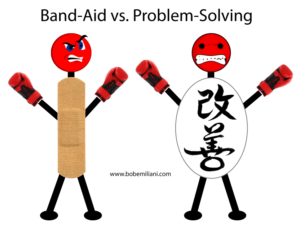copied from Adrian Lospa
There was a global company operating in many countries around the world. At one point, like all the “successful” companies, it got hit by a crisis. This affected the required product volumes by shrinking the customer needs. If the customers do not need the same volume of products, then the company needs to produce less. And now we come to the “cost reduction” measures in one of the countries were this company was located.
Managers: The sales are low, the production is low, this means we don’t need the same number of people to perform the work. Hmm, so let’s fire some people (not managers, of course), and let’s buy new company cars!
Employees: Wait, what? somebody from the corner asked.
Managers: Common, the managers said, you must understand us, our cars are around 5 years old and are not safe anymore… Don’t you care about our safety?
Employees: Then how come the company doesn’t have money to keep all the employees but affords to buy new cars?
Managers: You just don’t understand, actually we came with a cheaper solution, have you heard about operational leasing? It costs us less than buying new cars, it’s a so great that we thought about this!
Employees: No, I have no idea what operational leasing is, I have an old car..
Managers: Believe us, this is the right thing to do, and by the way, we need to fire around 30% of the current workforce. And let’ not forget about the stationery and printing costs! Please print on both sides of the paper if you really need it and think thoroughly if you really need colors or you just can stick with black and white! This will help us to lower the costs and to prove that we are engaged and protecting the environment! Please bear with us and understand the situation, we also have another great measure meant to help us! We will cut down the transportation costs! We will not pay anymore the bus transportation for each employee, we will hire a company to take all of you to work and back home!
Employees: How about the “old” cars? Can we buy them if those are “obsolete”?
Managers: Let’s not ask for those kind of favors, we will sell the cars to the company from where we will take the new ones! And by the way, in one or two years, when the crisis will be over, we can re-hire some of you!
Employees: Wow, thank you…
Managers: In the meantime, we wish you luck in finding another job so that you can take care of your family!
Employees: Gee, thanks..
